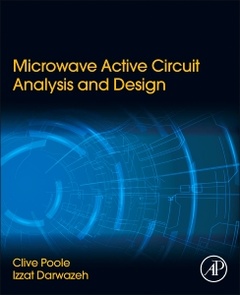Description
Microwave Active Circuit Analysis and Design
Authors: Poole Clive, Darwazeh Izzat
Language: English
Subjects for Microwave Active Circuit Analysis and Design:
664 p. · 19x23.3 cm · Hardback
Description
/li>Contents
/li>Readership
/li>Biography
/li>Comment
/li>
This book teaches the skills and knowledge required by today?s RF and microwave engineer in a concise, structured and systematic way. Reflecting modern developments in the field, this book focuses on active circuit design covering the latest devices and design techniques.
From electromagnetic and transmission line theory and S-parameters through to amplifier and oscillator design, techniques for low noise and broadband design; This book focuses on analysis and design including up to date material on MMIC design techniques.
With this book you will:
- Learn the basics of RF and microwave circuit analysis and design, with an emphasis on active circuits, and become familiar with the operating principles of the most common active system building blocks such as amplifiers, oscillators and mixers
- Be able to design transistor-based amplifiers, oscillators and mixers by means of basic design methodologies
- Be able to apply established graphical design tools, such as the Smith chart and feedback mappings, to the design RF and microwave active circuits
- Acquire a set of basic design skills and useful tools that can be employed without recourse to complex computer aided design
1. Introduction2. Transmission Line Theory3. Practical Transmission Lines4. The Smith Chart5. Immittance Parameters6. S-parameters7. Gain and Stability of Active Networks8. Three-Port Analysis Techniques9. Lumped Element Matching Networks10. Distributed Element Matching Networks11. Microwave Semiconductor Materials and Diodes12. Microwave Transistors and MMICs13. Microwave Amplifier Design14. Low-noise Amplifier Design15. Microwave Oscillator Design16. Low-noise Oscillator Design17. Microwave Mixers
Appendix A. Parameter Conversion TablesB. Physical ConstantsC. Forbidden Regions for L-Sections
Professional and graduate students of RF and microwave circuits
Izzat Darwazeh is the Chair of Communications Engineering in University College London (UCL) and head of UCL's Communications and Information Systems Group. He is an electrical engineering graduate of the University of Jordan and holds the MSc and PhD degrees from the University of Manchester in the UK. He has been teaching and active in microwave circuit design and communications circuits and systems research since 1991. He has published over 250 scientific papers and is the co-editor of the 1995 IEE book on Analogue Fibre Communications and of the 2008 Elsevier-Newness book on Electrical Engineering. He is also the co-author (with Luis Moura) of the 2005 book on Linear Circuit Analysis and
- Structured in the form of modular chapters, each covering a specific topic in a concise form suitable for delivery in a single lecture
- Emphasis on clear explanation and a step-by-step approach that aims to help students to easily grasp complex concepts
- Contains tutorial questions and problems allowing readers to test their knowledge
- An accompanying website containing supporting material in the form of slides and software (MATLAB) listings
- Unique material on negative resistance oscillator design, noise analysis and three-port design techniques
- Covers the latest developments in microwave active circuit design with new approaches that are not covered elsewhere




